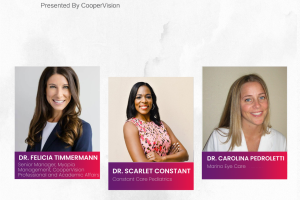
By Raphaella Tran, OD, MS, FAAO
As stewards of children’s vision and eye health, caring for children with myopia is more than the diagnosis. It’s more than the treatment, more than the research, and more than the advocacy from the frontlines of daily practice to those with federal and global reach. It’s all of it and more. The more we know, the more we realize the need and the work still to be done for children with myopia.
Recently, the National Academies of Sciences, Engineering, and Medicine released a report “Focus on Myopia: Pathogenesis and Rising Incidence.”1 This significant paper highlights myopia’s growing epidemic,2 addresses critical gaps, shares current evidence-based knowledge, and calls for more research to be done to help guide the path forward.
Myopia is not just a vision issue but an alarming public health concern with far-reaching implications.1 This consensus report serves as a critical step forward in addressing the myopia epidemic by providing actionable recommendations and reinforcing the importance of innovative solutions and treatment, such as MiSight® 1 day* for age-appropriate children, in controlling and saving as many diopters as possible.†3 Treating as close to onset is essential,4 as earlier onset leads to a higher risk of ocular morbidities that can impact quality of life with economic consequences.5-8
Dr. Priscilla Chang, OD, FAAO, IACMM, of CooperVision recently summarized the 10 key takeaways from the report:1
- Classify Myopia as a Disease. The report cites that myopia should be treated seriously due to its increasing prevalence and potential for later eye health complications.9 Myopia should be classified as a disease. And in doing so, should enhance awareness, treatment, and research funding, its authors suggest.
- Encourage Outdoor Time for Kids: Research continues to point to the importance of encouraging children to spend more time outdoors during daylight since it can help reduce the risk of myopia onset.10,11 Additionally, natural light exposure and focusing on distance objects are believed to play significant roles in reducing myopia risk.12 The report recommends that the CDC should provide evidence-based guidelines promoting at least one hour of outdoor time per day for kids.1
- Create Evidence-Based Treatment Guidelines: Treatment options for managing myopia progression have increased in recent years.1 Traditional optical corrections and refractive surgery don’t alter the risk of myopia complications.1 Interventions, such as MiSight® 1 day, have shown effectiveness in helping to slow myopia progression in age-appropriate children at the initiation of treatment.†3 Evidence-based treatment guidelines would help integrate such options into primary eye care, the report states.1
- Break Barriers to Vision Care: Multiple socioeconomic barriers to vision care for children are a real thing. These include a disparity in awareness of the importance of eye health exams and difficulties accessing care.1 The report’s action plan calls for an integrated data system to monitor vision screening, referrals, and follow-up care, especially in high-risk populations.
- Understand the Roles of the Environment and Genetics: The report dives into the influences of the environment and near work on myopia, in addition to the visual diet’s role, the latter of which refers to the variety of visual stimuli that enters the eye from the environment.1 Light exposure is believed to stimulate retinal pathways that have protective effects against myopia development. The report also looks into genetic contributions including hereditary factors and gene-environmental interactions, such as when children have parents with myopia and also do excessive near work or spend less time outdoors. Genetics has a little as 5% contribution to myopia.1
- Fund Research into the Pathogenesis and Mechanisms of Myopia: Funding is needed for multidisciplinary research to investigate the mechanisms of emmetropization and myopia, including retinal-scleral signaling and gene-environmental interaction, the authors note.1
- Close the Vision Screening Gaps: Many children don’t receive regular vision screenings, which can lead to late diagnoses of myopia.1 Further, there is no consensus on mandatory assessments and diagnostics for myopia exams.1 The report calls for screening protocols in schools and pediatric practices to ensure early detection and timely intervention for at-risk kids.
- Follow and Collect the Data: Ongoing data collection is important for tracking myopia trends and progression over time. Objective data can inform public health strategies and guide policymakers in allocating resources effectively to combat the myopia epidemic.
- Collaborate and Seek Funding, Create a Path Forward: The report identifies several federal and global agencies as key partners in addressing myopia, but also points to those on the front lines such as eye care professionals and parents. The report calls on the agencies to lead the development of comprehensive public health initiatives aimed at prevention, education, and research funding.
- Take Urgent Action Now: Myopia is an urgent public health issue that requires better awareness, classification as a disease, and increased funding for effective treatments, screening, and research. Early intervention and a multifaceted approach are key to making an impact of the myopia epidemic and children’s vision health.
You can download or read the full report here. Meanwhile, take action, collaborate, and advocate for children’s vision and eye health. The report makes it clear: each one of us should integrate these findings into our practices. Our daily contributions as champions for children with myopia make a difference and are an important part of the greater good.
Please take a minute to write a letter to your legislator for the Early Detection of Visual Impairment (EDVI) Act. The legislator lookup and letter template are mostly done for you.

Dr. Raphaella Tran is an associate at North Suburban Vision Consultants. She graduated summa cum laude at the University of Houston College of Optometry, where she also completed her Masters of Science in Physiological Optics and Vision Science. Her area of study and research for her Masters degree was in Myopia Management. She has presented her work at the American Academy of Optometry and the Association for Research in Vision and Ophthalmology conferences. She is currently a fellow of the American Academy of Optometry. Dr. Raphaella Tran specializes in myopia management, dry eye disease and specialty contact lens services. She is certified to fit myopia management contact lenses such as, but not limited to, MiSight®, and Paragon CRT®. She received her certificate for the Keratoconus Essentials Program and has been awarded the Ebling Award in Medical Contact Lenses, and the GP Lens Institute for Clinical Excellence for fitting sclerals, hybrids and gas permeable lenses for anterior segment diseases such as keratoconus, corneal ectasias and transplants. She also has experience with hard-to-fit lenses with higher-order aberration scleral in Ovitz and eye molds. During her time off, she enjoys spending time with her husband and taking their husky Dasher to enjoy the outdoors. Dr. Tran is also a Change Agent of The Myopia Collective representing the state of Illinois.








